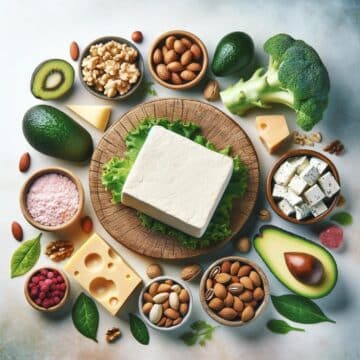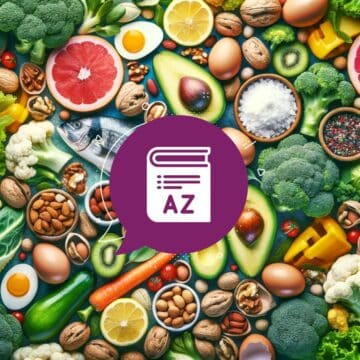Does your keto bread turn out crumbly no matter the recipe? Do you end up with brownie bits all over your shirt after every homemade batch? You may be missing an important ingredient here: xanthan gum.
Xanthan gum is an additive found in everything from pasta sauces, salad dressings, and ice creams to toothpaste and cosmetics.
In gluten-free and keto baking, it helps replace the properties of starch and gluten. Available as xanthan gum powder that you can find in the baking aisle or online, this ingredient is becoming increasingly common in keto kitchens everywhere.
If you’d like to know why that’s the case and what xanthan gum actually is, keep scrolling.
What is Xanthan Gum?
Xanthan gum is a polysaccharide and popular food additive. It is produced through the fermentation of simple sugars (glucose and sucrose) with the bacterium Xanthomonas campestris [1]. The word “gum” refers to gel-forming polysaccharides, thus the name.
Manufacturers of food, toothpaste, and cosmetics use it as a thickener and stabilizer. It is commercially available in powder form and can be found in the baking aisles of many supermarkets — but also online. It is highly viscous and gel-like when mixed with liquids, which makes it a good substitute for gluten, starch, and gelatin.
When used in home cooking/baking, xanthan gum can thicken and improve the mouthfeel of food. It can also stabilize but not emulsify ingredients. People on vegan, gluten-free, and keto diets use this ingredient to replace gelatin and wheat, among other things.
Why Use Xanthan Gum on Keto?
Because it can help replace gluten in starch — two things that are missing in keto baking but that are essential in dessert recipes.
Baked goods are normally made with wheat, which has gluten. Gluten is a type of protein that forms sticky and elastic fibers, and the word itself comes from Latin and means “glue.”
Keto desserts are not made with wheat but nut flours, which don’t have gluten or its equivalents. If not mixed with something to replace this “glue,” your keto desserts may fall apart or become crumbly.
Another problem with wheat-free baking is that without gluten, the dough won’t rise and hold its shape. Gluten traps air bubbles produced through yeast fermentation and carbon dioxide produced from baking soda.
Xanthan gum can make nut flour dough sticky and elastic. It can help bind all the baking ingredients and help you get the texture of regular dough. It can also thicken puddings, custards as well as soups and sauces.
And best of all, you only need to use a small amount. You will rarely need to use more than a tablespoon in most recipes, and on average, you’ll use about half a teaspoon.
If you’re worried about xanthan gum net carbs — it has none! Xanthan gum is an indigestible carbohydrate, a fiber essentially. Studies have long ago shown that it acts like dietary fiber in the digestive tract, increasing stool bulk and absorbing intestinal bile and cholesterol [2]. It also has no effect on blood glucose or insulin levels.
Is Xanthan Gum Healthy?
Xanthan gum is a food additive, and many consider it to be far from natural. It’s normal to be concerned about its effects on your health. You probably went on the keto diet to improve your health, so you’re not likely going to use ingredients that will potentially be harmful.
The good news is that you have nothing to worry about. The FDA considers it safe for human consumption [3]. And The Panel on Food Additives and Nutrient Sources added to Food has said in their 2017 re-evaluation of xanthan gum that there is no safety concern regarding xanthan gum as a food additive [4].
So xanthan gum is definitely safe, but is it healthy?
Xanthan gum seems to provide the same health benefits as other dietary fibers. Clinical research shows it suppresses blood glucose spikes after meals [5]. And as mentioned earlier, it can help increase stool bulk, which can help improve bowel movement frequency and relieve constipation.
Small amounts of xanthan gum are needed for the above health benefits — up to 15g per day. Taking more than that can put you at risk of digestive upset, like nausea, bloating, and gas. But that’s the case with excess fiber intake in general.
Conclusion
The keto diet, with its focus on nut flours and non-starchy foods, can make it hard for you to enjoy baked goods and thick puddings. After all, these foods are normally made with flour and starch, which give them their luscious texture.
Using xanthan gum can help keto eaters achieve the texture of wheat-based foods. This complex carb has high viscosity and binding properties just like gluten. It also acts as a thickener in liquids. Best of all, it’s proven to be safe and potentially even healthy. If you come across it in the baking aisle, pick up a bag and see what culinary magic it can create in your keto kitchen.
References
- R.Y. Lochhead. Chapter 13 - The Use of Polymers in Cosmetic Products. Cosmetic Science and Technology, Elsevier. 2017; 171-221. doi.org/10.1016/B978-0-12-802005-0.00013-6
- EFSA Panel on Food Additives and Nutrient Sources added to Food (ANS), Mortensen A, Aguilar F, et al. Re-evaluation of xanthan gum (E 415) as a food additive. EFSA J. 2017;15(7):e04909. Published 2017 Jul 14. doi:10.2903/j.efsa.2017.4909
- FDA/CEDR resources page. Code of Federal Regulations Title 21. Revisited April 2020. https://www.accessdata.fda.gov/scripts/cdrh/cfdocs/cfcfr/cfrsearch.cfm?fr=172.695
- Eastwood MA, Brydon WG, Anderson DM. The dietary effects of xanthan gum in man. Food Addit Contam. 1987;4(1):17-26. doi:10.1080/02652038709373610
- Tanaka H, Nishikawa Y, Kure K, Tsuda K, Hosokawa M. The Addition of Xanthan Gum to Enteral Nutrition Suppresses Postprandial Glycemia in Humans. J Nutr Sci Vitaminol (Tokyo). 2018;64(4):284-286. doi:10.3177/jnsv.64.284
- Tanaka H, Nishikawa Y, Kure K, Tsuda K, Hosokawa M. The Addition of Xanthan Gum to Enteral Nutrition Suppresses Postprandial Glycemia in Humans. J Nutr Sci Vitaminol (Tokyo). 2018;64(4):284-286. doi:10.3177/jnsv.64.284








Chris says
FYI, there is another reason not to eat gelatin - red meat allergy (alpha gal). If I ate gelatin, it would kill me.
S says
I have a degree in Holistic Nutrition and sorry but I don't agree with any of this as the gums are just not good for you. However, organic, grass fed gelatin is and works just as well. Unless you are kosher which is the only reason not to use gelatin. You ought to do a side-by-side test.
Tisa says
Hi. Appreciate every comment on this topic. However, could you please elaborate? We are genuinely interested to read about what health risk the gums pose if occasionally used in tiny amounts. Thank you.